Post 9 6-25-2016, revised 1-8-2022
Turntable with pit Construction & Operation - Homemade and Scratch Built and Inexpensive ($10 !) How to Build any Size Turntable with Pit for $10
The center piece of the layout is the scratch built, inexpensive turntable and roundhouse. Designing and building the turntable was the most fun part of the whole train layout for me and well worth the time and effort as it provides much operation interest and fun. The Turntable was built during the initial layout construction in 1977 in Kingston Jamaica.
The turntable can be built the same way I made this one for any size of table one needs and for any gauge of train track. It can be rotated by crank, pullies and belt like mine or rotated with an junk electric DC battery drill or screwdriver motor powered by a small, cheap DC HO transformer and located any where on a layout. If your layout is already built, the turntable can be more easily built in a 2 or 3 ft or so, square module, in your work shop and then set into the layout. The turntable can be detailed from Toy 027 to scale, depending on the builder desires.

Turntable Description and Construction Details
The turntable rotates on a 6 inch diameter (8" might be better for a larger TT) Lazy Susan, metal turntable ball bearing unit and rotation is by a hand crank driving a pulley beneath the turntable using a spare or used clothes dryer drum belt. I purchased the 6 inch diameter lazy Susan turntable ball bearing unit, for about $5, at a hardware store. I had a spare dryer belt as I lived overseas and appliance parts are hard to get. Track alignment is the realistic, "line it by eyeball" method and roundhouse track selection is by a rotary switch. A momentary push button switch is used to activate the selected RH track and the TT track. A light in the TT shack comes on with the activation of the TT track and indicates power is on. The turntable has a pit as that is more realistic and better looking in my view. It would have been easier to surface mount a Lazy Susan bearing on the train table like the Lionel TT, but seeing it made a pit a must have.
Location of the control panel and the turntable, with hand crank, should be fairly close to each other for two reasons. One is the use of a clothes dryer belt will require it to be close. The other is it is helpful for the engineer to be close at hand to correct derailments and to see the turntable as eyesight is used to align the TT and the tracks.
The homemade turntable can be belt driven with a hand crank like mine or can have an old battery driven screw driver as power and the TT can be located anywhere. More details later in this post.
Picture of TT with TT crank (red knob) and Control Panel - Picture shows the track with crane car and caboose align with the TT and the off track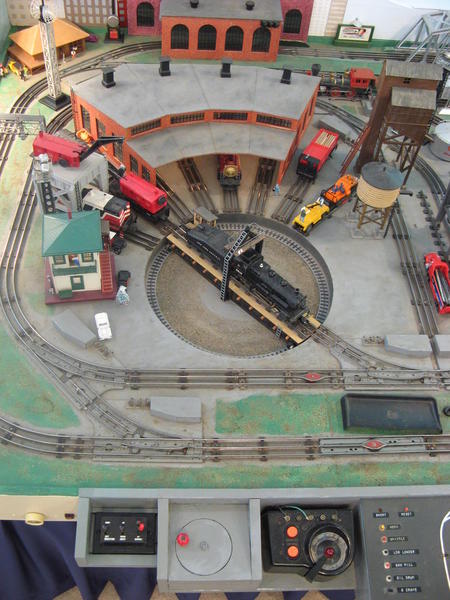
Picture of main control panel track diagram with selector rotary switch (black knob with pointer) to select track for transfer of train from TT to spur/roundhouse track. The black push button momentary switch, below the rotary selector switch, controls power to the selected track and the turntable track.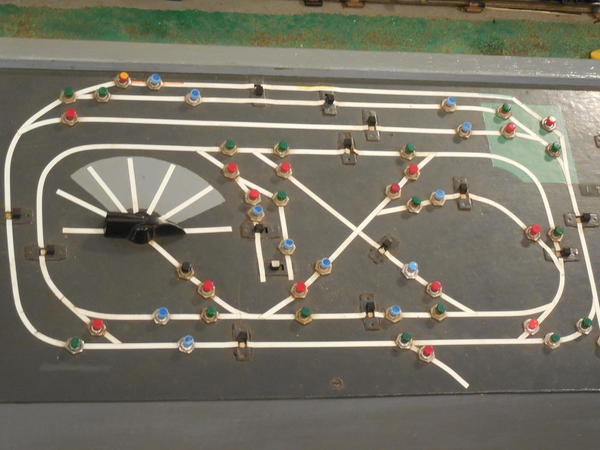
Two pieces of 027 track or 17 5/8 inches was chosen for the turntable bridge length. 17 5/8 inch diameter will handle all of my engines and coal tenders at the time I built it. Two more inches of length would have been better and handle my later bought larger engines and coal tenders but space was at a premium I cut a 17 5/8 inch diameter circle in my 3/4 inch thick particle board train board using a sabre saw and used the ¾ inch thick, 17 5/8 inch diameter cutout as a pulley by adding a rim of 1/8 inch Masonite around both edges as pulley flanges sticking out about ½ an inch.
Most of the work on the TT was done with my train board section standing on edge, leaning against a wall. To build a TT for an existing permanent layout on legs would require lots of work under the table and looking up. In such a case one might want to build a two foot or so module to construct the TT and install as a unit.
A recessed ring around the turntable hole, about 1&1/2 inch deep, was installed on the bottom of the hole and a 1/2" plywood bottom was added. A 3/8" hole was centered in both TT bottom and the pulley. A 2"x 2" x 3/4 inch block was drilled in the center to take a 3/8 threaded hollow lamp rod. The block and rod were mounted about 1 inch from the rods end and drilled for a 2 inch long finish nail. The block was glued and screwed to the pulley in the center.
A 6" lazy Susan ball bearing (Ace or Home Depot for $4) was screwed to the top of the pulley. Four 1 inch diameter holes were drilled through the pulley for the screws on the other flange of 6” lazy Susan bearing. These holes allow the bearing to be screwed to the underside of the pit bottom.
The lazy Susan bearing will hold all the weight of the pulley and take the side thrust from the clothes dryer belt. The 3/8” threaded hollow lamp rod allows thin, flexible twin wire to feed power to the TT bridge and to secure the bridge to the pulley beneath the TT pit.
The 3/8" dia. threaded hollow lamp rod was installed through the pulley and the rod was pinned block on the pulley with a nail. The rod was measured to the length needed to go through the pulley, block, TT bottom and to the top of the TT bridge minus a ¼ inch, sawed off, and a hole drilled through the bridge to be able to pin the rod to the TT bridge to be built.
A pair of wires were run up through the 3/8" dia threaded hollow lamp rod and soldered to the outside and middle rail of the track that was put on the TT bridge. Some slack was left in the wire and a type of disconnect like a plug or spring clips ( I used two electrical connectors cut from old 9v batteries) was installed to allow removal of wire to unwind the wire if it gets twisted too much (I also try not to keep going is one direction too much!)
Picture of 17 5/8"dia. Pulley under Turntable with Clothes Dryer Belt and wires from TT Bridge
A spare electric clothes dryer belt, that is about 3/8" wide and 1/8"thick and about 8 to 10 feet in total length (not diameter) ,was used to move the TT. This is the size of most any make of clothes dryer. The belt is super strong, as after all it must apply power to 20 pounds plus of wet cloths in dryer drum, from the motor to the drum.
I made a hand crank out of a 6" long 1/4" carriage bolt as the driving pulley with disk and knob held on to the disk with a Tee nut and locking nut as the crank. Over sized Tee nuts were used for shaft sleeves for the shaft, top and bottom. A small pulley was made for the shaft from a ¼ inch ID radio shaft coupling and two brass grommets soldered together to make a Vee to give more bite on the belt by the small shaft. This Vee is necessary to keep the belt from slipping on the small diameter shaft of the crank and also make the diameter larger than the shaft.
Picture of Hand Crank Vee pulley made from radio tuner shaft coupling (seen with the set screws showing) and brass grommets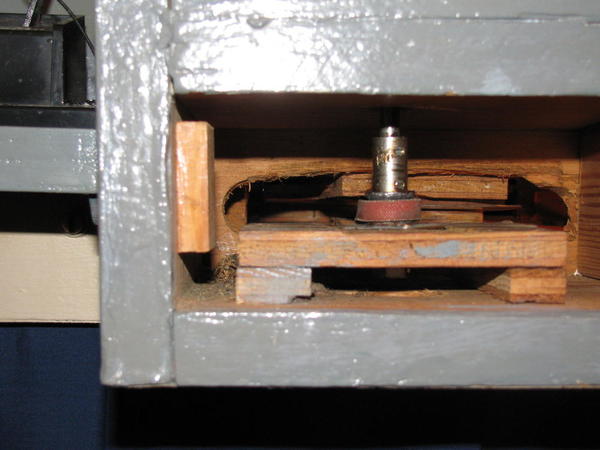
A 2" dia. take up pulley assembly was made and a threaded rod used to move it to make and adjust the tension in the dryer belt. The threaded rod was installed on the 1"x6" edge of the train board near the control panel. I installed a 3" dia. pulley to make an S in the belt routing to allow belt tensioning. A 2” dia. pulley was used to make the belt stay about ½ inch apart after coming of the ½ inch Vee pulley on the hand crank to insure good 180 degree contact with the Vee pulley. Pulleys are made from 1/2 inch plywood with flanges of 1/8 inch Masonite having polyethylene next to wood from coffee can lids.
Picture of Belt Routing - Belt length total is 8 to 10 ft not diameter on drawing.
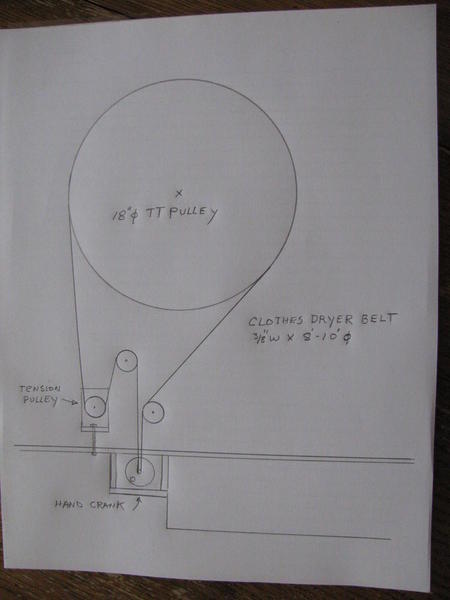
Picture of Pulleys and Belt - Tension adjuster on bottom belt with wood box with metal strap, the hand crank with Vee pulley is to the left of the picture. The two pulleys force the belt to have maximum contact around the Vee pulley (180 degrees).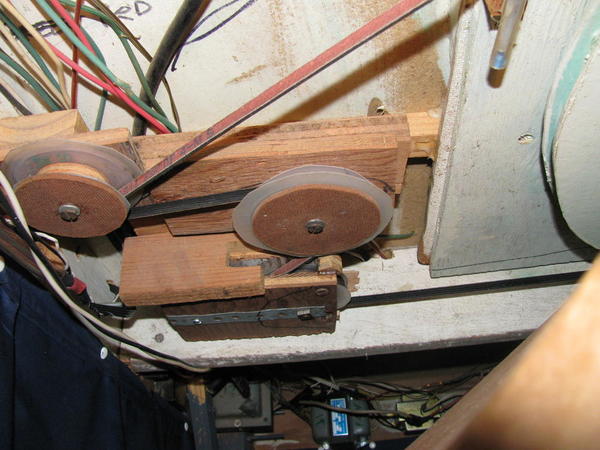
A turntable bridge was made out of wood and the bridge was pinned to the 3/8" dia threaded lamp rod with a finishing nail. The 3/8” dia threaded lamp rod is anchored to the bottom of the 17 5/8“ pulley and on top of the TT bridge with two 3/8" dia lamp round thumb nuts.
Small wheels were made for the ends of the Turntable Bridge to transfer the weight of the bridge and locomotive with coal tender to floor of the TT pit (I used some small ball bearings I had for wheels).
See picture of the TT bridge wheels (note the Sharpie pen ties and rail on the floor of the TT pit ! ) 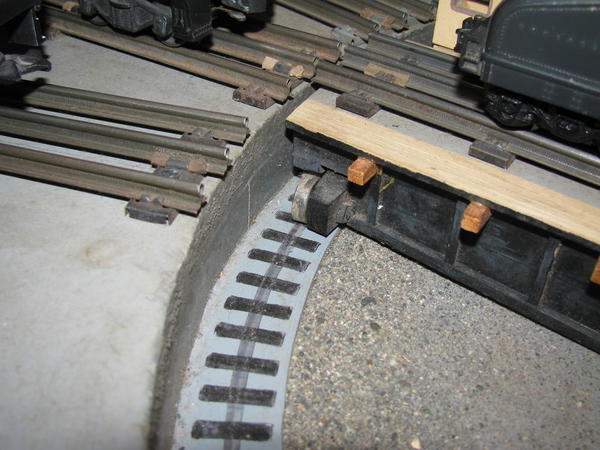
Wiring of the Turntable and Round House/Spur Tracks
Tracks were added to store trains around the TT being careful of spacing between tracks. The tracks were wired to a Radio Shack rotary 10 position switch to select the track to be powered. A momentary contact push button switch (with black push button) was installed on the control panel and wired in series to allow the selected track and turntable bridge track to only be powered when this switch is held down.
The turntable track and all the Round House/stall tracks have common outside rails. The center rails of the Round House/stall tracks are each wired individually to a spot on the rotary selector switch on the control panel (see Picture below) thus allowing only one stall track to get power at a time.
Turntable Operation
Once the RH track is selected, pushing down the momentary black push button switch on the control panel allows that track and the TT track are wired for the red lighted LW trans on the right to control the engine to go from the inside loop, over the TT and into that elected stall.
I do not have a diagram. All of the center rails of the stall and TT track are wired to the black push button switch. The other terminal of the black push button switch is wired to the output of the Red lighted LW trans. When the TT track and selected stall track are activated by the momentary switch and power from the Red LW is applied, a light comes on in the little house on the TT to indicate power is on the TT.
The Red lighted Trans always controls the stall tracks, TT track and all of the inside loop on the main board. It also is wired to all switches on the inside loop of the main board.
Picture Below:
See the RH track selector switch with black pointer knob: Black push button switch that must be pushed for power to go to selected RH track and turntable is below the black knob on track to TT. Red and green buttons are for switches and blue are uncoupling track sections. Black slide switches turn on and off the section of track they are on. The black slide switches show "white" on and "black" off. All tracks are blocked and controlled by a slide switch. All rail switches are always hot or on.
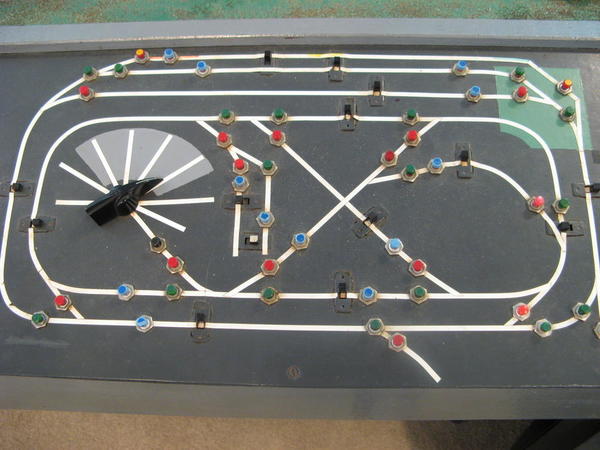
With the selector switches above the red lighted LW transformer can also control the outside loop of the main board as another selection or it can control the outside loop of main board and the new train board thus giving it control of every piece of track on the whole board.
Note on picture below, that one track aligns with the TT and the approach track. This is the only track that a wrecker caboose and crane car can be sent over the TT and be stored around the TT. I made sure to leave this track outside of my future Round house to be built and detailed later.
Picture of Track that will allow work caboose and crane car to be stored 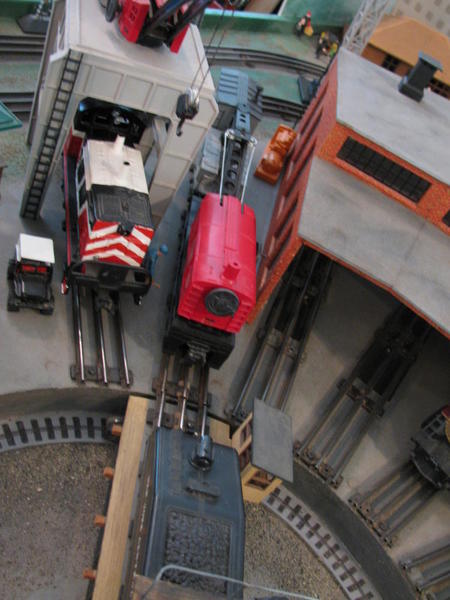
This TT can be detailed to any extent or even scale quality and I detailed my TT for a Toy 027 1950s type of layout.
I added details like the lighted TT operator shack, ladders on the bridge to the pit made from cut up N gauge track ties (remove the rails and cut out with every other tie), a TT bridge central tower for overhead wire with ladder, pigeons and poop, and Sharpie penned in rail and ties in the TT pit.
TT bridge has 1/8 inch smooth Masonite deck, grooved with knife to look like wood planks and painted buff to look like wood. Some sieved coarse sand was glued into the pit bottom.
Picture of Turntable with center mast and ladder, exposed ties, birds, and pit track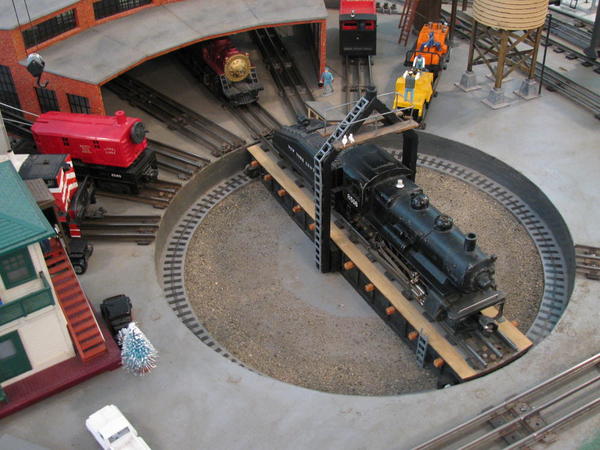
A close up of TT power tower and pigeons, ladders were made from plastic ties from N gauge track with every other tie cut out with X-acto knife or diagonal pliers
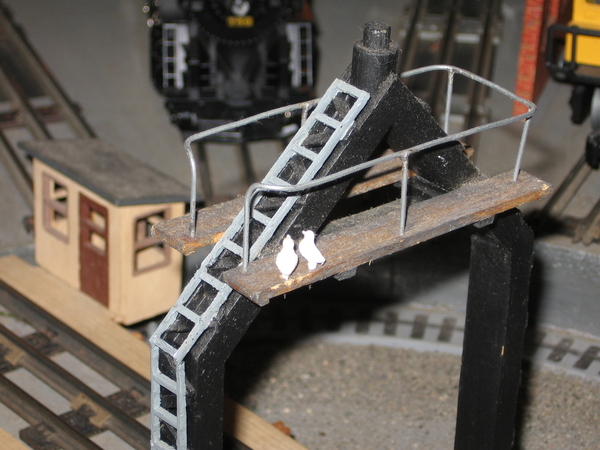
A TT control cable tower was made from wood and a TT operator shack were made later to add important detail to the TT Bridge. Also note the wooden support beams for the TT decking and ladders.
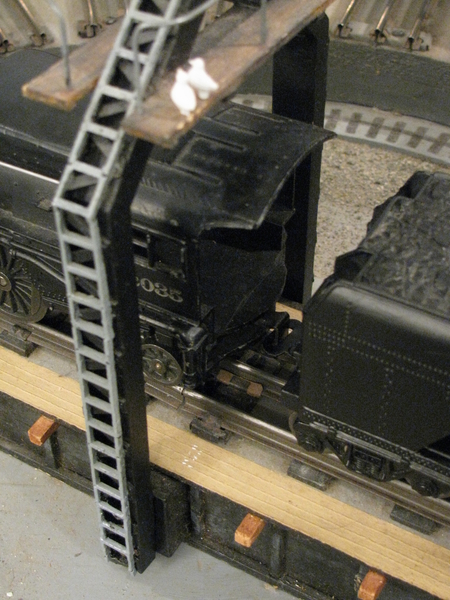
This project takes time, planning and careful measurements to make it all work. Care must be given to aligning and screwing down the tracks so derailments are few or at least blamed on the TT operator !
To summarize:
A great operating turntable with pit can be built for $10 and using only a hand held jig or saber saw, 1/4 inch electric drill and soldering gun
The turntable can be made for any gauge trains, any size or length of turntable, and located anywhere by automating TT rotation via battery DC junk electric drill or screwdriver motor :all up to the builder.
The TT really did cost me less than $10 since I had a spare clothes dryer belt. You could get a belt from a junked clothes dryer, as a used belt is plenty good for this. Buy a new one for your current dryer and use the old one for the TT !
The turntable uses an inexpensive, easy to find Lazy Susan metal turntable ball bearing unit, to provide smooth and accurate rotation of the turntable. I used a used clothes dryer belt to provide rotation of the turntable via a hand crank for my turntable.
Remote or Power Operation of this Turn Table
If you do not want to place the TT close to the edge of your layout and be restricted by location due to the length of the clothes dryer belt, one can power the turntable with a used DC electric drill or screw driver motor. Junked DC electric drills and screw drivers show up often at garage sales and thrifts as it costs a lot to buy new batteries and is often cheaper to buy a new tool. The drill motor could be powered with a small cheap HO DC transformer in both directions. This would be easy to power the TT with a shorter belt and pulley on the drill and the the TT could be located anywhere on your layout.
The TT has worked well since 1977 or almost 44 years and is very reliable. It would not turn in 2015 and after investigation, the cause was a broken solder joint on one of the grommets on the Vee pulley. The original was soldered with a 100 watt soldering gun (the only soldering tool I had) and it lasted 38 years. I re-soldered the Vee with a propane torch, with a soldering iron tip, that gets much hotter.
Post 11 shows how I built a $10 Roundhouse.
Charlie









